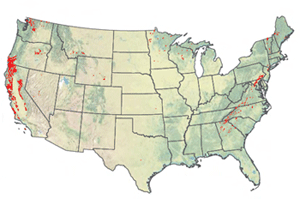
Courtesy U.S. Geological Survey
Whether we like it or not, we’re going to have to learn how to sequester CO2. Current suggestions include storing liquid or gaseous CO2 underground in saline aquifers, depleted oil wells, and porous coal seams. These “solutions” however come with nuclear-bomblike thrills of unintended consequences: notably, sudden and unintentional leaks.
But there’s another idea. Turning carbon back into a solid. Which just happens to be a way to permanently get rid of CO2 emissions. Our ally in that mission is rock. And geologists have now mapped 6,000 square miles of ultramafic rocks at or near the surface in the US (map [pdf]) that could absorb more than 500 years of America’s CO2 production. Most of these formations are clustered along the east and west coasts, some near major cities, including New York, Baltimore, and San Francisco, making the sequestration process downright convenient—someday. Soon. We hope.
Here’s how it works: Ultramafic rocks originate deep in the Earth and contain minerals that react naturally with CO2 to form solid minerals—a process known as mineral carbonation. Columbia University’s Earth Institute scientists are experimenting with ways to speed up a process that under natural conditions takes thousands of years.
One model involves capturing CO2 directly from power-plant smokestacks and other industries, dissolving in water and piping it underground, while capturing the heat generated by the reaction to accelerate the process. The first major pilot study is underway in Iceland, where a collaboration of international researchers will inject CO2-saturated water into basalt formations, also good sequesters. The rock should absorb 1,600 tons of CO2 from a nearby geothermal power plant over 9 months.
That’s not all. Another mapping effort is underway in Oman, where peridotite formations might mineralize as much as 4 billion tons of CO2 a year—about 12 percent of the world’s annual output. And another pilot study by the Pacific Northwest National Laboratory will eventually inject 1,000 tons of C02 into rock under land owned by a paper mill in Washington.
But wait, there’s more. Hazardous tailings left behind by asbestos mining in Vermont and California could finally be neutralized by CO2 sequestration. The asbestos was mined from peridotite formations and the tailings are just waiting to gobble CO2 and return to their former lives as mantle rocks benign enough for your mantlepiece.













